Selective Photocatalytic Transformation of Lignin to Aromatic Chemicals by Crystalline Carbon Nitride in Water–Acetonitrile Solutions
Abstract
1. Introduction
2. Materials and Methods
2.1. Preparation of Materials
2.2. Material Characterization
2.3. Photocatalytic Experiments
3. Results and Discussion
3.1. Morphology Analysis
3.2. Characterization of Physicochemical Properties
3.3. Optoelectronic Properties
3.4. Photocatalytic Performance
3.5. The Photocatalytic Conversion Mechanism
4. Conclusions
Supplementary Materials
Author Contributions
Funding
Institutional Review Board Statement
Informed Consent Statement
Data Availability Statement
Conflicts of Interest
References
- Schutyser, W.; Renders, A.T.; Van, S.; Koelewijn, S.F.; Beckham, G.T.; Sels, B.F. Chemicals from lignin: An interplay of lignocellulose fractionation, depolymerization, and upgrading. Chem. Soc. Rev. 2018, 47, 852–908. [Google Scholar] [CrossRef]
- Li, C.; Zhao, X.; Wang, A.; Huber, G.W.; Zhang, T. Catalytic transformation of lignin for the production of chemicals and fuels. Chem. Rev. 2015, 115, 11559–11624. [Google Scholar] [CrossRef] [PubMed]
- Xu, C.; Arancon, R.A.D.; Labidi, J.; Luque, R. Lignin depolymerization strategies: Towards valuable chemicals and fuels. Chem. Soc. Rev. 2014, 43, 7485–7500. [Google Scholar] [CrossRef] [PubMed]
- Rinaldi, R.; Jastrzebski, R.; Clough, M.T.; Ralph, J.; Kennema, M.; Bruijnincx, P.C.; Weckhuysen, B.M. Paving the way for lignin valorization: Recent advances in bioengineering, biorefining and catalysis. Angew. Chem. Int. Ed. 2016, 55, 8164–8215. [Google Scholar] [CrossRef] [PubMed]
- Wu, X.; Luo, N.; Xie, S.; Zhang, H.; Zhang, Q.; Wang, F.; Wang, Y. Photocatalytic transformations of lignocellulosic biomass into chemicals. Chem. Soc. Rev. 2020, 49, 6198–6223. [Google Scholar] [CrossRef] [PubMed]
- Dong, L.; Lin, L.F.; Han, X.; Si, X.Q.; Liu, X.H.; Guo, Y.; Lu, F.; Rudic, S.; Parker, S.F.; Yang, S.H.; et al. Breaking the limit of lignin monomer production via cleavage of interunit carbon-carbon linkages. Chem 2019, 5, 1521–1536. [Google Scholar] [CrossRef]
- Tan, J.; Li, Z.; Li, J.; Wu, J.; Yao, X.; Zhang, T. Graphitic carbon nitride-based materials in activating persulfate for aqueous organic pollutants degradation: A review on materials design and mechanisms. Chemosphere 2021, 262, 127675. [Google Scholar] [CrossRef]
- Zhang, G.; Huang, D.; Cheng, M.; Lei, L.; Chen, S.; Wang, R.Z.; Xue, W.J.; Liu, Y.; Chen, Y.S.; Li, Z.H. Megamerger of MOFs and g-C3N4 for energy and environment applications: Upgrading the framework stability and performance. J. Mater. Chem. A 2020, 8, 17883–17906. [Google Scholar] [CrossRef]
- Wang, Y.; He, J.; Zhang, Y. CeCl3-promoted simultaneous photocatalytic cleavage and amination of Cα-Cβ bond in lignin model compounds and native lignin. CCS Chem. 2020, 2, 107–117. [Google Scholar] [CrossRef]
- Liu, H.; Li, H.; Luo, N.; Wang, F. Visible-light-induced oxidative lignin C-C bond cleavage to aldehydes using vanadium catalysts. ACS Catal. 2019, 10, 632–643. [Google Scholar] [CrossRef]
- Li, Z.; Li, B.; Chen, J.; Pang, Q.; Shen, P. Spinel NiCo2O4 3-D nanoflowers supported on graphene nanosheets as efficient electrocatalyst for oxygen evolution reaction. Int. J. Hydrog. Energy 2019, 44, 16120–16131. [Google Scholar] [CrossRef]
- Asadzadeh-Khaneghah, S.; Habibi-Yangjeh, A.; Vadivel, S. Fabrication of novel g-C3N4 nanosheet/carbon dots/Ag6Si2O7 nanocomposites with high stability and enhanced visible-light photocatalytic activity. J. Taiwan Inst. Chem. Eng. 2019, 103, 94–109. [Google Scholar] [CrossRef]
- Feng, C.; Tang, L.; Deng, Y.; Zeng, G.; Wang, J.; Liu, Y.; Chen, Z.M.; Yu, J.F.; Wang, J. Enhancing optical absorption and charge transfer: Synthesis of S-doped h-BN with tunable band structures for metal-free visible-light-driven photocatalysis. Appl. Catal. B 2019, 256, 117827. [Google Scholar] [CrossRef]
- Liu, H.; Li, H.; Lu, J.; Zeng, S.; Wang, M.; Luo, N.; Xu, S.T.; Wang, F. Photocatalytic cleavage of C-C bond in lignin models under visible light on mesoporous graphitic carbon nitride through π-π stacking interaction. ACS Catal. 2018, 8, 4761–4771. [Google Scholar] [CrossRef]
- Ku, C.H.; Guo, H.Q.; Li, K.X.; Wu, Q.; Yan, L.S. One-step fabrication of mesoporous sulfur-doped carbon nitride for highly selective photocatalytic transformation of native lignin to monophenolic compounds. Chin. Chem. Lett. 2023, 34, 107298. [Google Scholar] [CrossRef]
- Ku, C.H.; Li, K.X.; Guo, H.Q.; Wu, Q.; Yan, L.S. One-step construction of mesoporous cyano and sulfur co-modified carbon nitride for photocatalytic valorization of lignin to functionalized aromatics. Appl. Surf. Sci. 2022, 592, 153266. [Google Scholar] [CrossRef]
- Wang, Y.; Wang, X.; Antonietti, M. Polymeric graphitic carbon nitride as a heterogeneous organ catalyst: From photochemistry to multipurpose catalysis to sustainable chemistry. Angew. Chem. Int. Ed. 2012, 51, 68–89. [Google Scholar] [CrossRef]
- Hasija, V.; Raizada, P.; Sudhaik, A.; Sharma, K.; Kumar, A.; Singh, P.; Thakur, V.K. Recent advances in noble metal free doped graphitic carbon nitride based nanohybrids for photocatalysis of organic contaminants in water: A review. Appl. Mater. 2019, 15, 494–524. [Google Scholar] [CrossRef]
- Zeng, Z.X.; Yu, H.; Quan, X.; Chen, S.; Zhang, S. Structuring phase junction between tri-s-triazine and triazine crystalline C3N4 for efficient photocatalytic hydrogen evolution. Appl. Catal. B 2018, 227, 153–160. [Google Scholar] [CrossRef]
- Yang, Z.; Li, L.; Yu, H.; Liu, M.; Chi, Y.; Sha, J.; Xu, S. Facile synthesis of highly crystalline g-C3N4 nanosheets with remarkable visible light photocatalytic activity for antibiotics removal. Chemosphere 2021, 271, 129503. [Google Scholar] [CrossRef]
- Liu, Q.; Cheng, H.; Chen, T.; Lo, T.W.B.; Xiang, Z.; Wang, F. Regulating the *OCCHO intermediate pathway towards highly selective photocatalytic CO2 reduction to CH3CHO over locally crystallized carbon nitride. Energy Environ. Sci. 2022, 15, 225–233. [Google Scholar] [CrossRef]
- Shao, S.; Wang, K.; Love, J.B.; Yu, J.; Du, S.; Yue, Z.; Fan, X. Water promoted photocatalytic Cβ-O bonds hydrogenolysis in lignin model compounds and lignin biomass conversion to aromatic monomers. Chem. Eng. J. 2022, 435, 134980. [Google Scholar] [CrossRef]
- Li, Y.; Zhang, D.; Feng, X.; Xiang, Q. Enhanced photocatalytic hydrogen production activity of highly crystalline carbon nitride synthesized by hydrochloric acid treatment. Chin. J. Catal. 2020, 41, 21–30. [Google Scholar] [CrossRef]
- Lau, V.W.H.; Moudrakovski, I.; Botari, T.; Weinberger, S.; Mesch, M.B.; Duppel, V.; Senker, J.; Blum, V.; Lotsch, B.V. Rational design of carbon nitride photocatalysts by identification of cyanamide defects as catalytically relevant sites. Nat. Commun. 2016, 7, 12165. [Google Scholar] [CrossRef] [PubMed]
- Liang, Z.; Zhuang, X.; Tang, Z.; Deng, Q.; Li, H.; Kang, W. High-crystalline polymeric carbon nitride flake composed porous nanotubes with significantly improved photocatalytic water splitting activity: The optimal balance between crystallinity and surface area. Chem. Eng. J. 2022, 432, 134388. [Google Scholar] [CrossRef]
- Li, K.; Zhao, D.; Li, Y.; Luo, S.; Zhou, Z. The synergistic photocatalytic effects of surface-modified g-C3N4 in simple and complex pollution systems based on a macro-thermodynamic model. Environ. Sci. Nano 2021, 8, 217–232. [Google Scholar] [CrossRef]
- Liu, X.; Wang, P.; Zhai, H.; Zhang, Q.; Huang, B.; Wang, Z.; Liu, Y.Y.; Dai, Y.; Qin, X.; Zhang, X. Synthesis of synergetic phosphorus and cyano groups (CN) modified g-C3N4 for enhanced photocatalytic H2 production and CO2 reduction under visible light irradiation. Appl. Catal. B 2018, 232, 521–530. [Google Scholar] [CrossRef]
- Feng, C.; Tang, L.; Deng, Y.; Wang, J.; Liu, Y.; Ouyang, X.; Wang, J. A novel sulfur-assisted annealing method of g-C3N4 nanosheet compensates for the loss of light absorption with further promoted charge transfer for photocatalytic production of H2 and H2O2. Appl. Catal. B 2021, 281, 119539. [Google Scholar] [CrossRef]
- Gao, L.; Li, X.; Zhao, J.; Zhang, X.; Zhang, X.; Yu, H. In situ preparation of (BiO)2CO3/BiOBr sheet-on-sheet heterojunctions with enhanced visible light photocatalytic activity. J. Phys. Chem. Solids. 2017, 108, 30–38. [Google Scholar] [CrossRef]
- Battula, V.R.; Kumar, S.; Chauhan, D.K.; Samanta, S.; Kailasam, K. A true oxygen-linked heptazine based polymer for efficient hydrogen evolution. Appl. Catal. B 2019, 244, 313–319. [Google Scholar] [CrossRef]
- Wang, X.; Wang, F.; Sang, Y.; Liu, H. Full-spectrum solar-light-activated photocatalysts for light-chemical energy conversion. Adv. Energy Mater. 2017, 7, 1700473. [Google Scholar] [CrossRef]
- Popov, E.; Mametkuliyev, M.; Santoro, D.; Liberti, L.; Eloranta, J. Kinetics of UV-H2O2 advanced oxidation in the presence of alcohols: The role of carbon centered radicals. Environ. Sci. Technol. 2010, 44, 7827–7832. [Google Scholar] [CrossRef] [PubMed]
- Chen, Y.F. Step-by-Step Hydrothermal Preparation of Carbon Microspheres in Camellia oleifera Seed Shell and Study on the Mechanism of Spherical Formation. Master’s Thesis, Nanchang Hangkong University, Nanchang, China, 2020. [Google Scholar] [CrossRef]

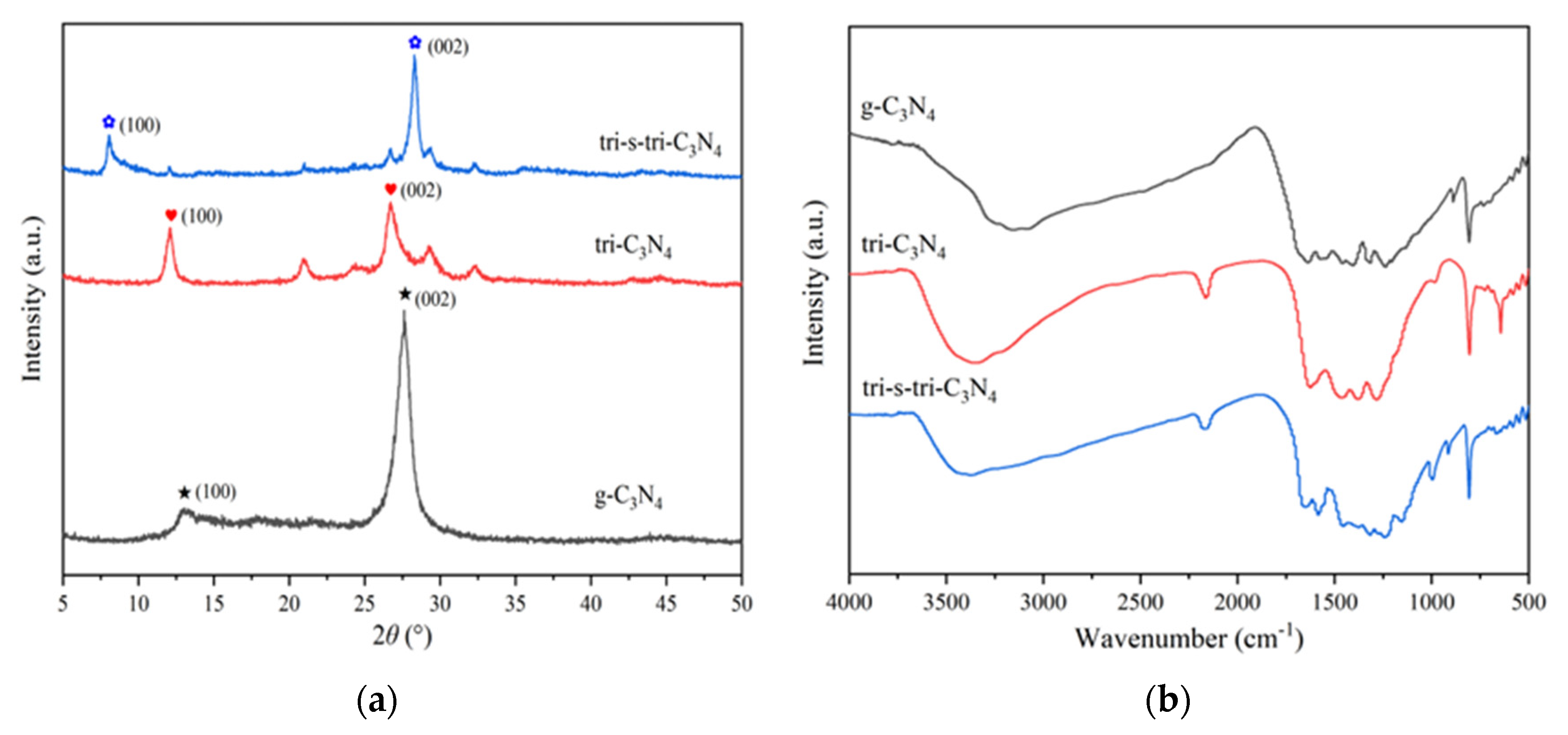

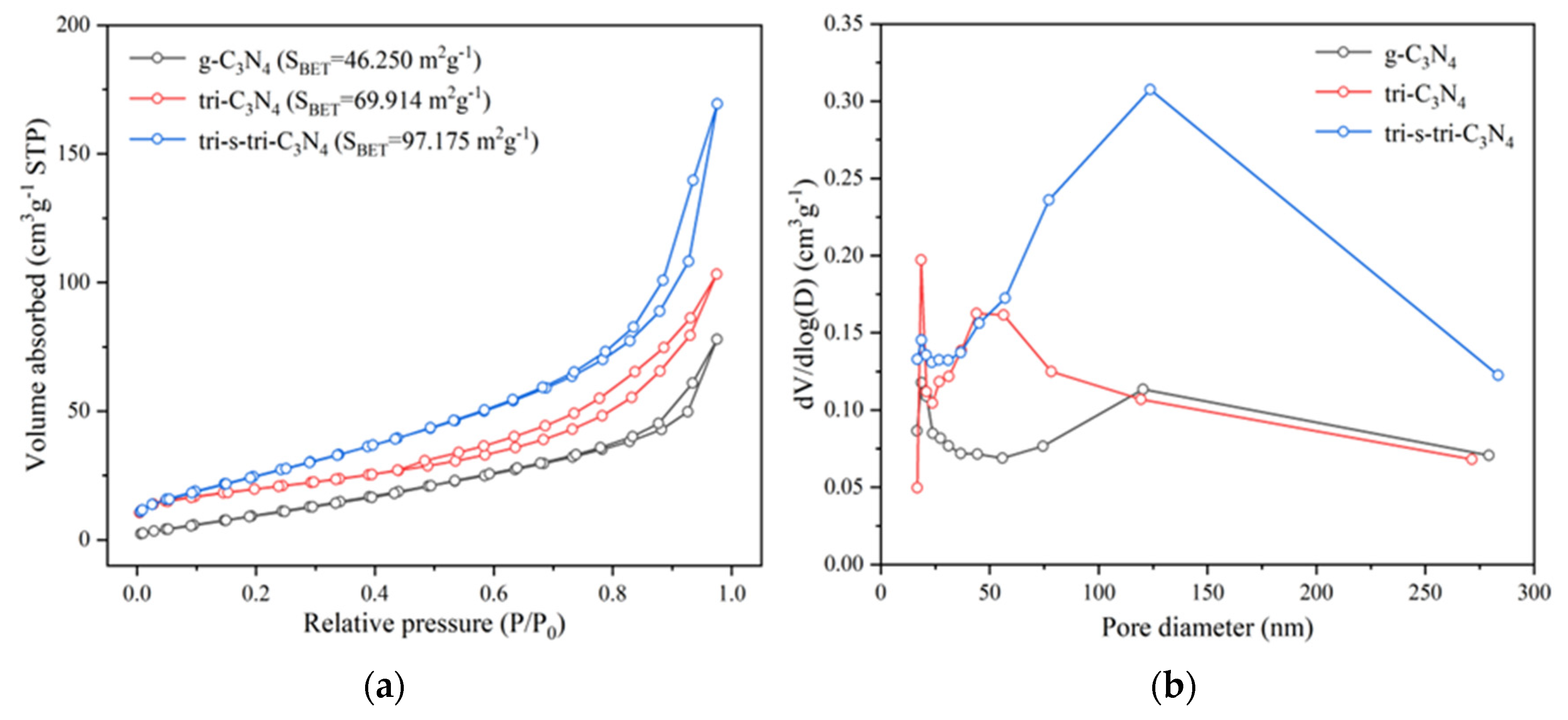

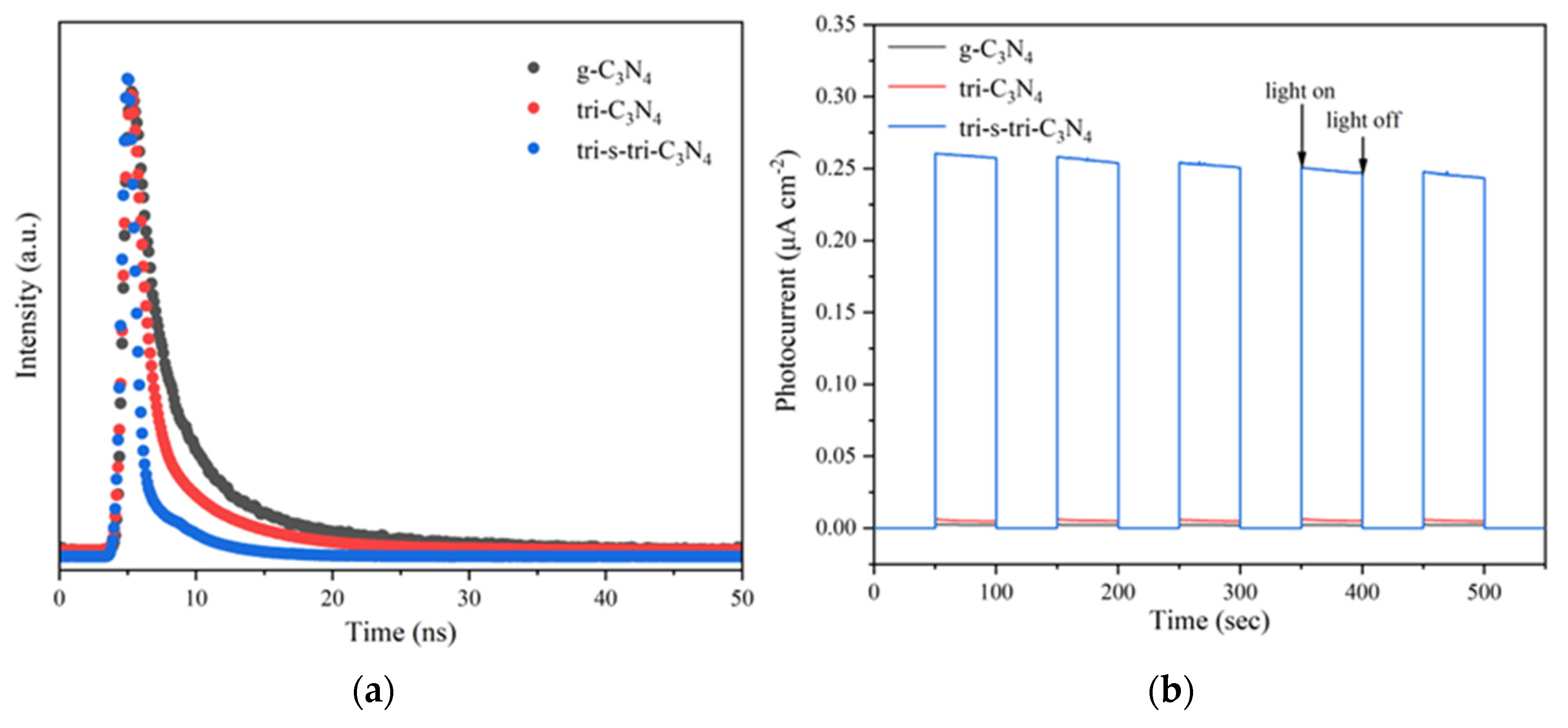
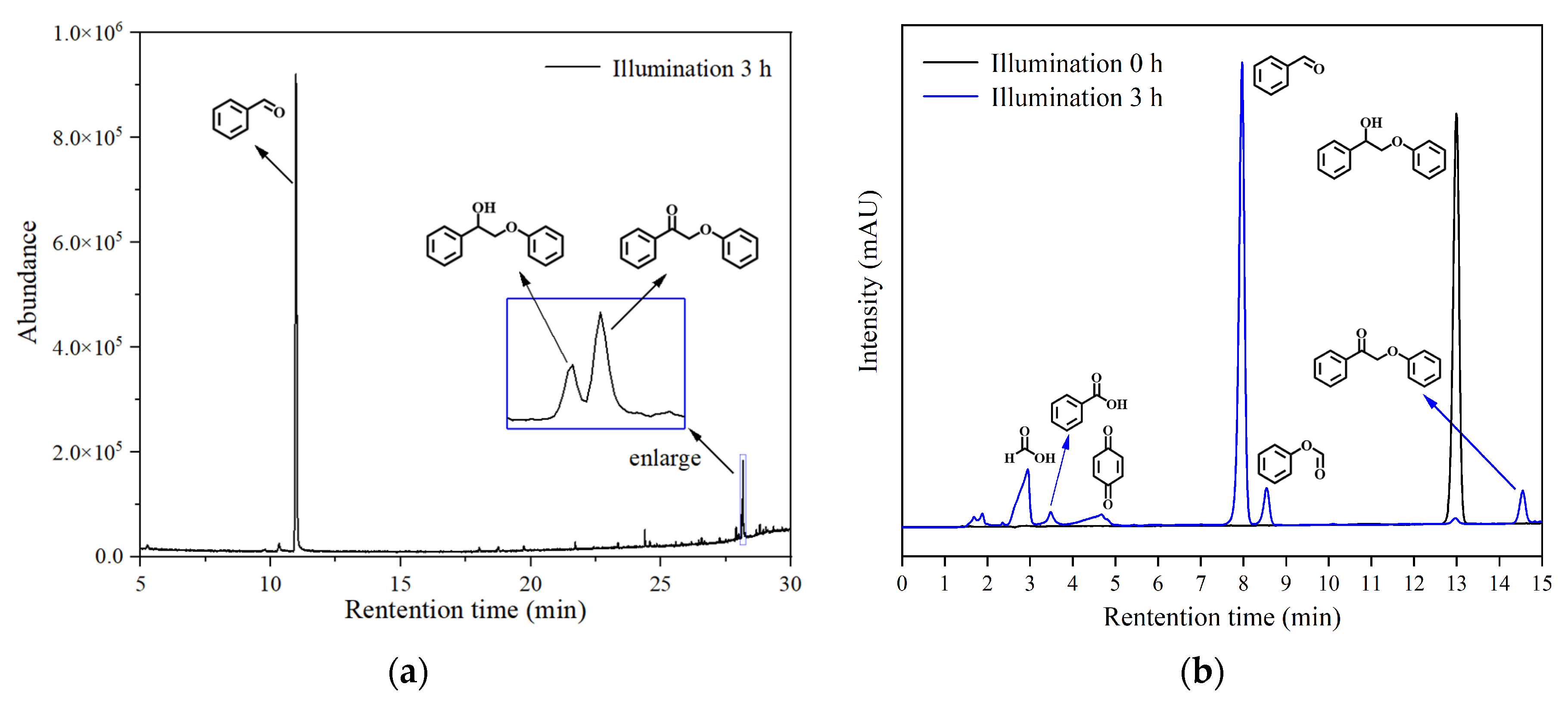

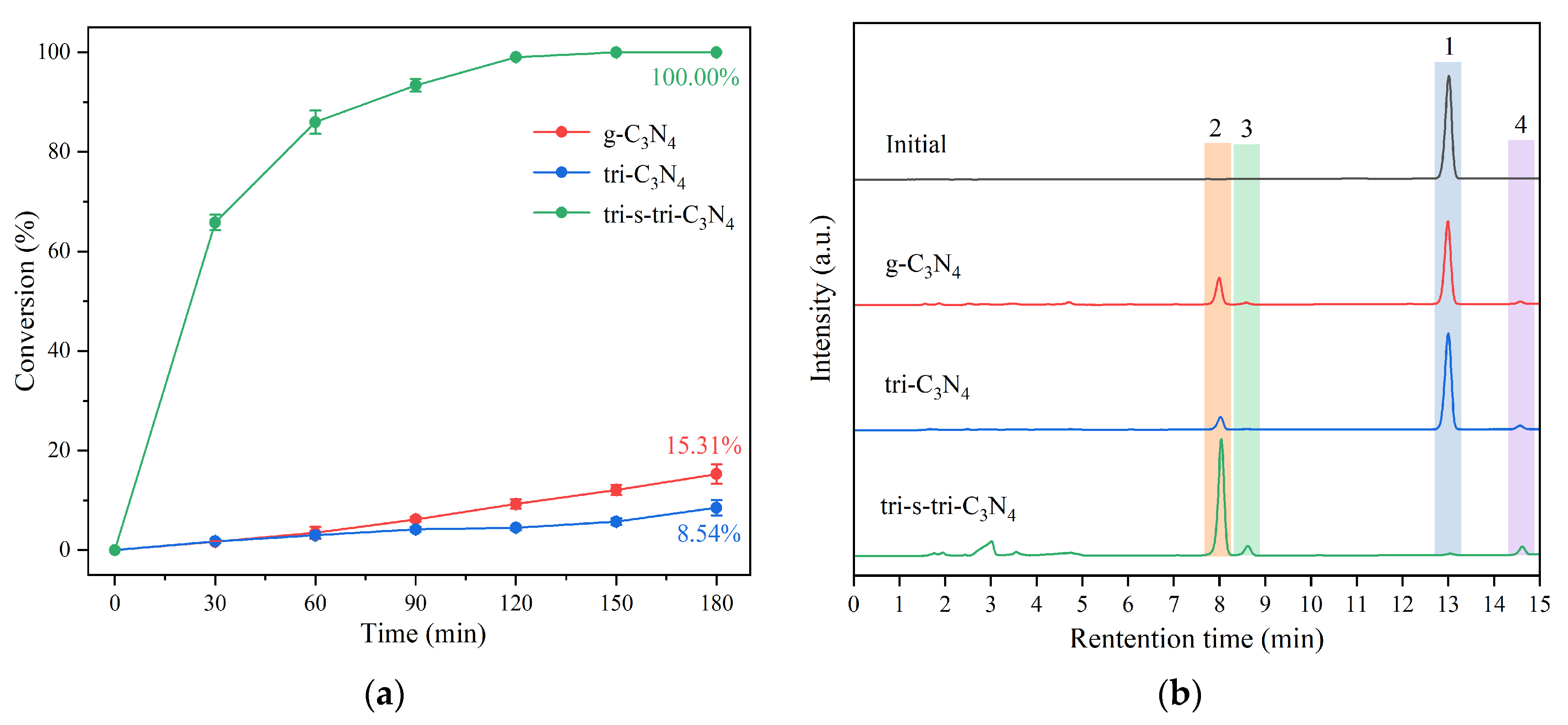
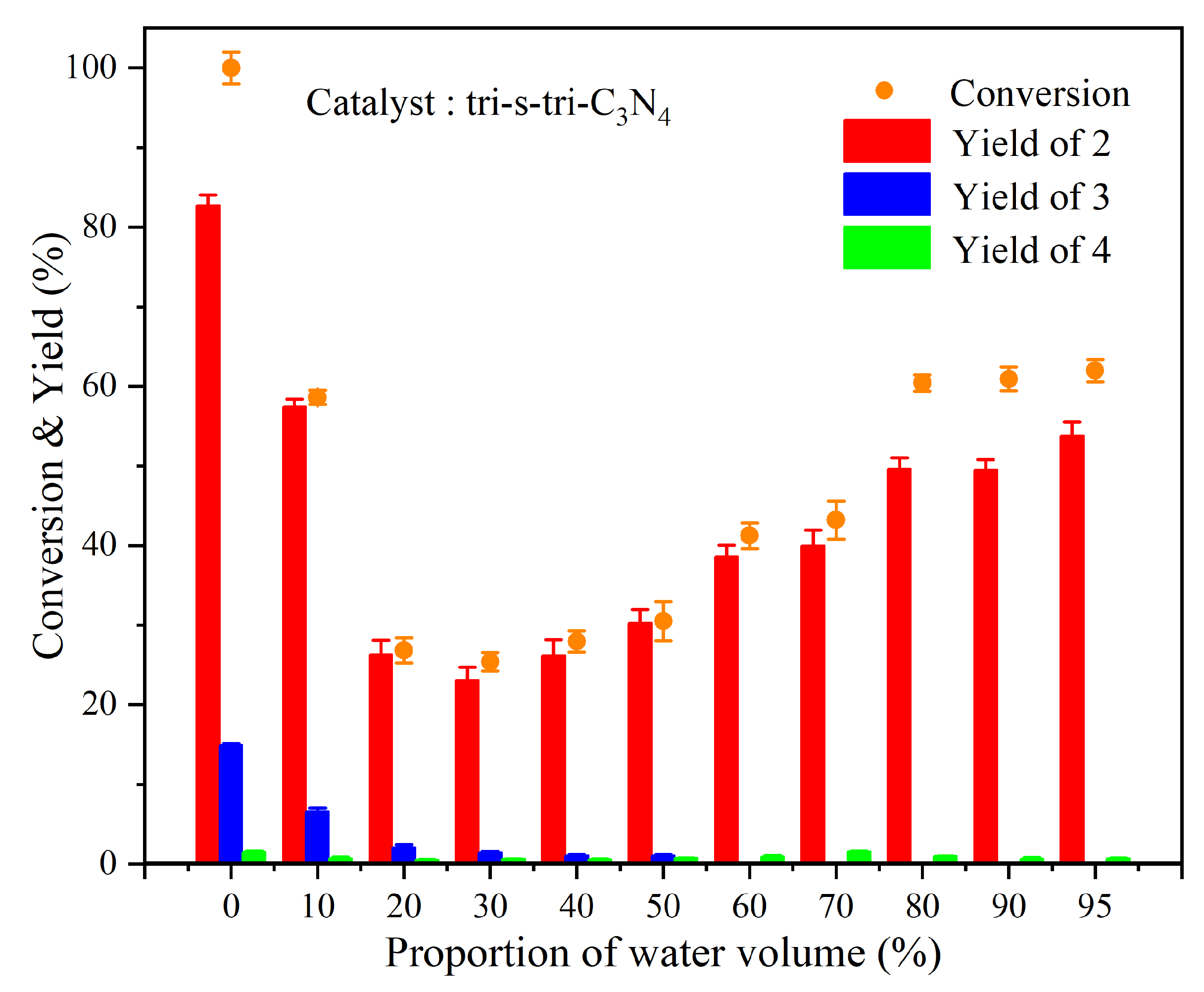
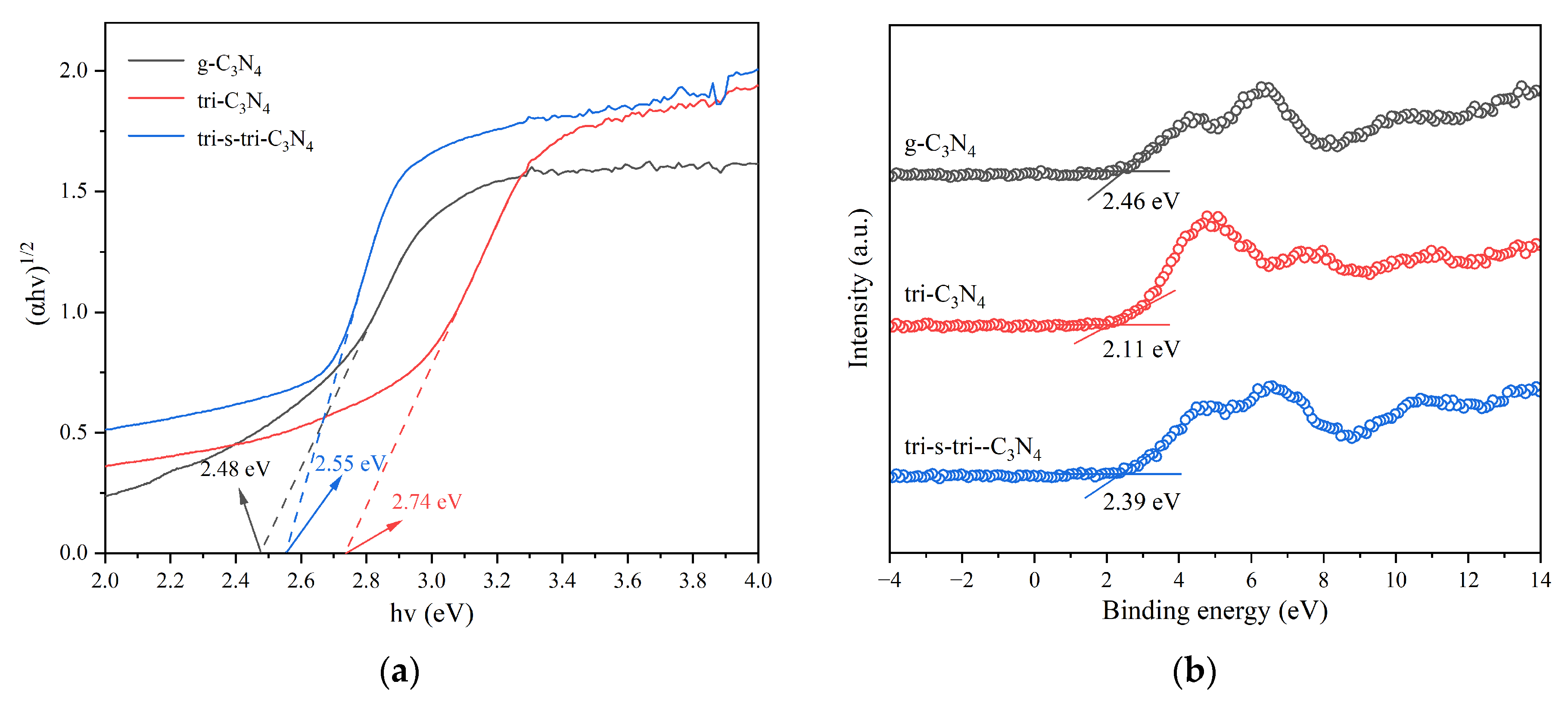
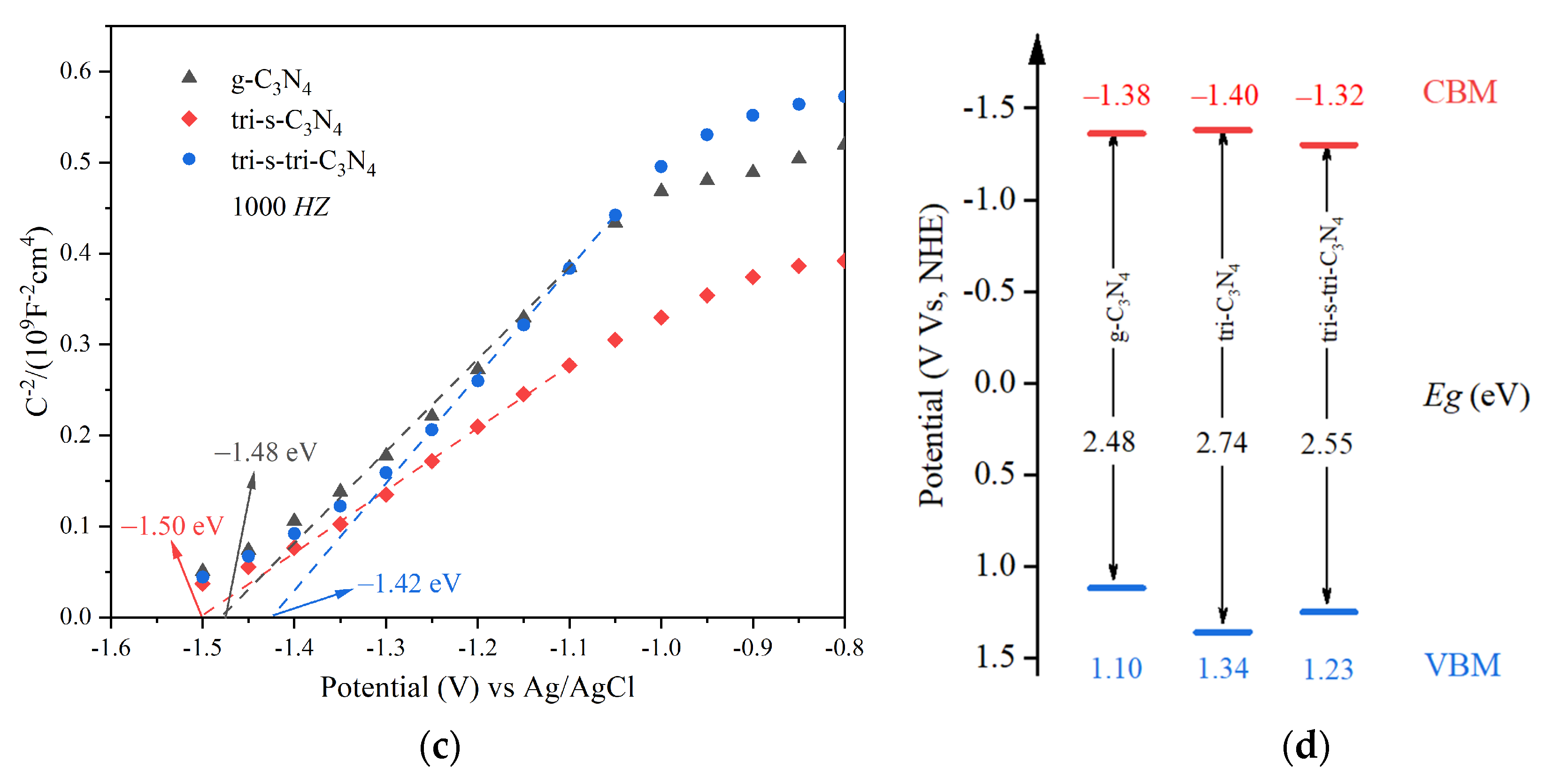
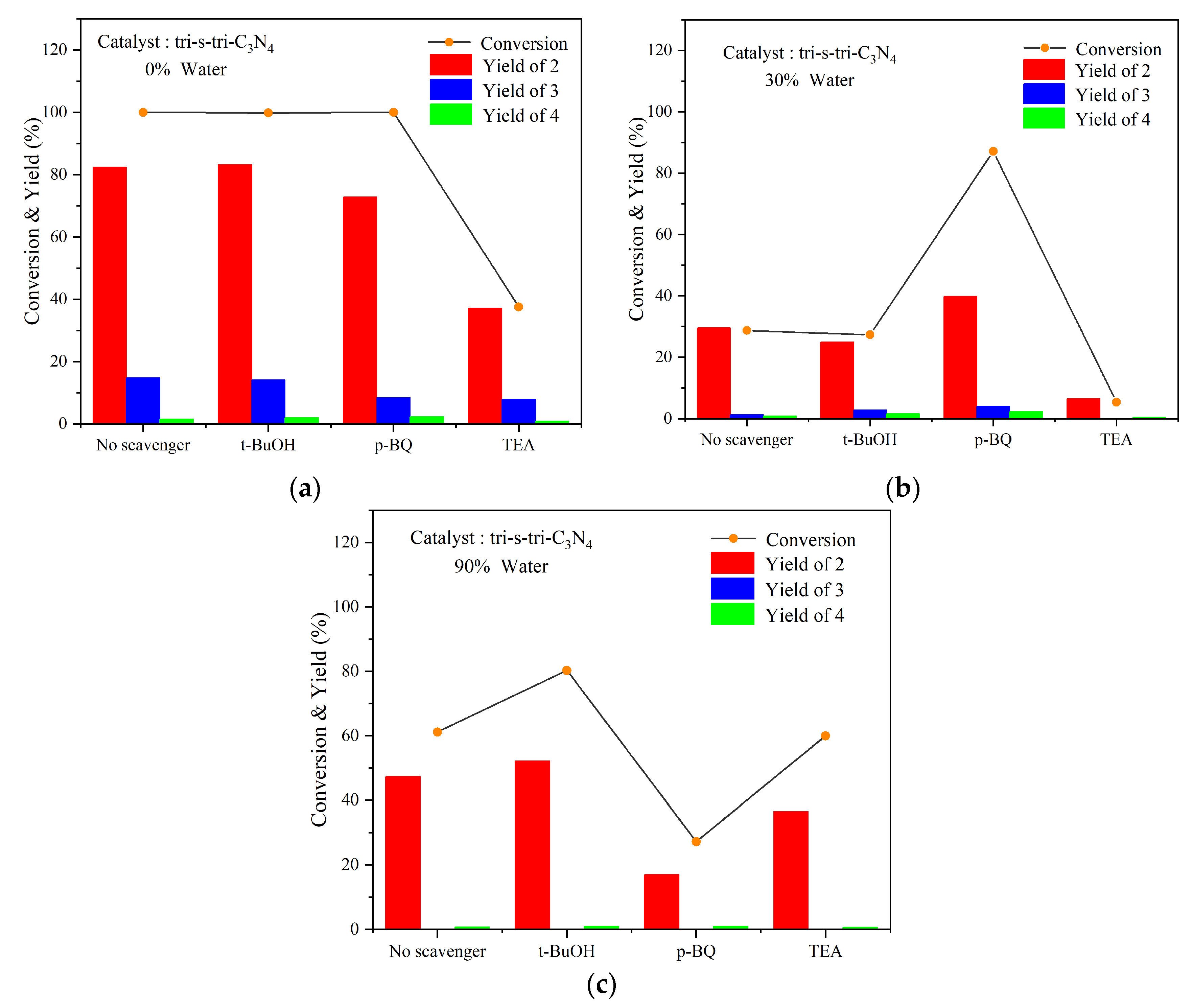

| Group | Catalyst | Conversion of 1 (%) | Product Yield (%) | Cα-Cβ Cleavage Selectivity (%) | ||
|---|---|---|---|---|---|---|
| 2 | 3 | 4 | ||||
| 1 | None a | 0 | - | - | - | 0 |
| 2 | g-C3N4 a | 15.31 | 14.70 | 2.66 | 0.47 | 96.02 |
| 3 | tri-C3N4 a | 8.54 | 8.47 | 1.18 | 0.71 | 99.20 |
| 4 | tri-s-tri-C3N4 a | 100.00 | 84.90 | 14.05 | 1.52 | 84.90 |
| 5 | tri-s-tri-C3N4 b | 8.37 | 8.00 | 2.42 | 0.35 | 95.58 |
| 6 | tri-s-tri-C3N4 c | 40.70 | 36.12 | 6.58 | 1.95 | 88.75 |
| 7 | tri-s-tri-C3N4 d | 36.80 | 35.33 | 6.57 | 2.29 | 96.01 |
| 8 | tri-s-tri-C3N4 e | 1.24 | - | - | - | 0 |
| Group | Acetonitrile–Water Volume Ratio | Conversion of 1 (%) | Product Yield (%) | Cα-Cβ Cleavage Selectivity (%) | ||
|---|---|---|---|---|---|---|
| 2 | 3 | 4 | ||||
| 1 | 100–0 | 100.00 | 84.90 | 14.91 | 1.49 | 84.90 |
| 2 | 90–10 | 58.61 | 57.44 | 6.60 | 0.74 | 98.00 |
| 3 | 80–20 | 26.84 | 26.32 | 2.12 | 0.54 | 98.06 |
| 4 | 70–30 | 25.39 | 23.06 | 1.44 | 0.65 | 90.82 |
| 5 | 60–40 | 27.94 | 26.23 | 1.09 | 0.62 | 93.88 |
| 6 | 50–50 | 30.51 | 30.33 | 1.09 | 0.77 | 99.41 |
| 7 | 40–60 | 41.25 | 38.59 | - | 0.98 | 93.55 |
| 8 | 30–70 | 43.19 | 39.96 | - | 1.54 | 92.52 |
| 9 | 20–80 | 60.43 | 49.61 | - | 1.01 | 82.09 |
| 10 | 10–90 | 60.95 | 49.46 | - | 0.66 | 81.15 |
| 11 | 5–95 | 62.00 | 53.82 | - | 0.70 | 86.80 |
Publisher’s Note: MDPI stays neutral with regard to jurisdictional claims in published maps and institutional affiliations. |
© 2022 by the authors. Licensee MDPI, Basel, Switzerland. This article is an open access article distributed under the terms and conditions of the Creative Commons Attribution (CC BY) license (https://creativecommons.org/licenses/by/4.0/).
Share and Cite
Huang, M.; Guo, H.; Zeng, Z.; Xiao, H.; Hu, H.; He, L.; Li, K.; Liu, X.; Yan, L. Selective Photocatalytic Transformation of Lignin to Aromatic Chemicals by Crystalline Carbon Nitride in Water–Acetonitrile Solutions. Int. J. Environ. Res. Public Health 2022, 19, 15707. https://doi.org/10.3390/ijerph192315707
Huang M, Guo H, Zeng Z, Xiao H, Hu H, He L, Li K, Liu X, Yan L. Selective Photocatalytic Transformation of Lignin to Aromatic Chemicals by Crystalline Carbon Nitride in Water–Acetonitrile Solutions. International Journal of Environmental Research and Public Health. 2022; 19(23):15707. https://doi.org/10.3390/ijerph192315707
Chicago/Turabian StyleHuang, Meirou, Huiqin Guo, Zhenxing Zeng, Hong Xiao, Hong Hu, Liu He, Kexin Li, Xiaoming Liu, and Liushui Yan. 2022. "Selective Photocatalytic Transformation of Lignin to Aromatic Chemicals by Crystalline Carbon Nitride in Water–Acetonitrile Solutions" International Journal of Environmental Research and Public Health 19, no. 23: 15707. https://doi.org/10.3390/ijerph192315707
APA StyleHuang, M., Guo, H., Zeng, Z., Xiao, H., Hu, H., He, L., Li, K., Liu, X., & Yan, L. (2022). Selective Photocatalytic Transformation of Lignin to Aromatic Chemicals by Crystalline Carbon Nitride in Water–Acetonitrile Solutions. International Journal of Environmental Research and Public Health, 19(23), 15707. https://doi.org/10.3390/ijerph192315707







